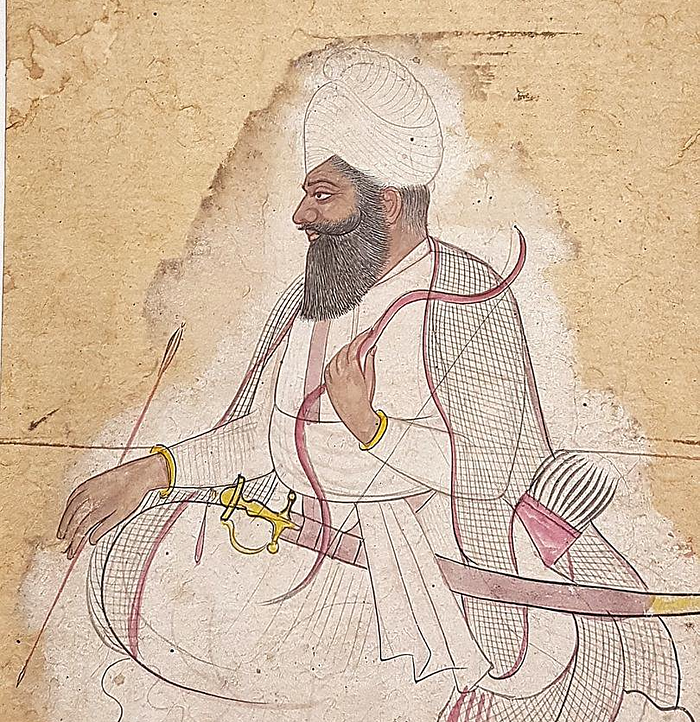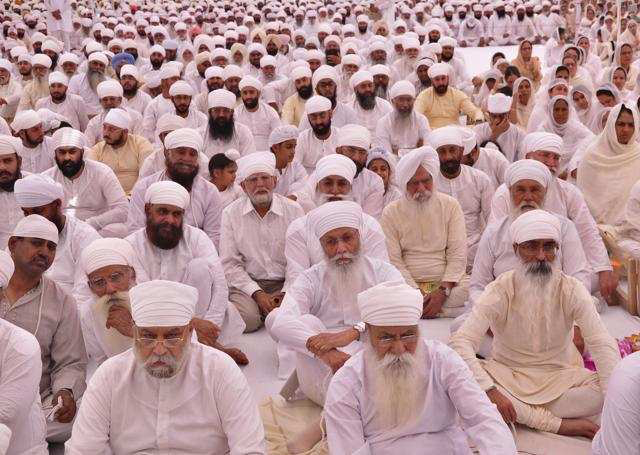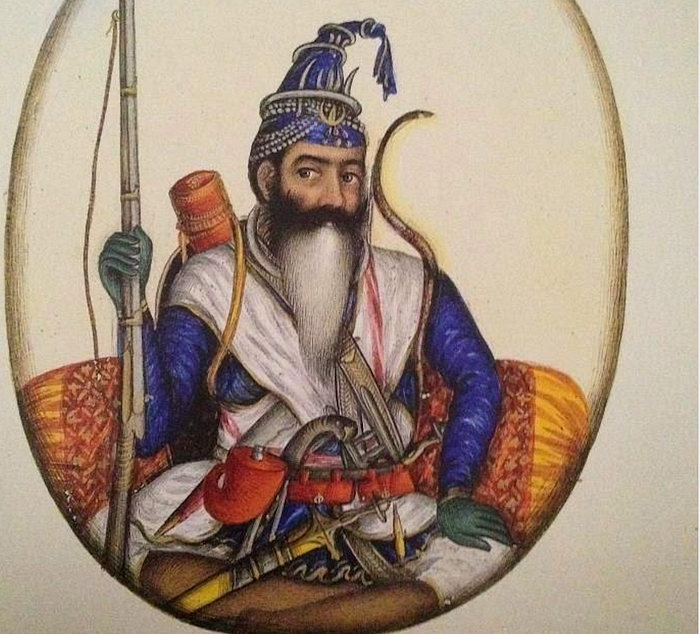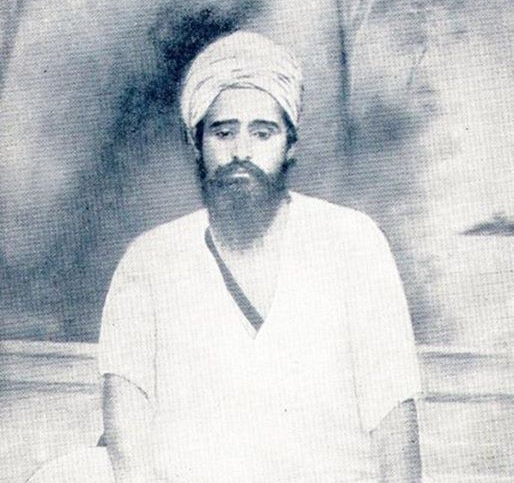A Visual History of the Sikh Turban
The Sikh faith is known for the external markers of the Khalsa identity, most prominently the uncut hair covered by a turban. It is a testament to the emphasis laid in the earliest Rehits (Khalsa code of conduct) on the turban as a mark of a warrior-king that the Sikh turban persists to this day — but one question that lingers is how the Sikh turban developed to this point through history. This article tries to give a brief treatment of the topic by looking at artwork and photography throughout Sikh history to show how although the symbolism and strength behind the Sikh turban has remained strong, the specific style in which it’s expressed has evolved quite a good bit.
PERIOD I — The Sikh Gurus (~1500-1700)
The first type of turban we see in Sikh history is the type that the Gurus tied, and assumedly other affluent Sikhs in the times of the first 9 Gurus (and perhaps some Khalsa Sikhs as well). Contra to the perception that the Gurus created an altogether new and unique style of turban, they tied what we can call a royal Indic turban that was popular among the royal classes in North India at the time.

This turban stemmed from Rajput tradition, and was adopted by the Mughals starting with Akbar (who was the first Mughal emperor to shift away from his Turkic roots and embrace Indic custom and culture) and would be continued among further Mughals.

With Mughal adoption, this turban style proliferated to the royal and aristocratic classes across North India, such as martial Hindu groups like the Marathas and Jaats who were vying for power in their own spheres of influence across a soon-to-be-post-Mughal India.


The Sikh Gurus would also therefore wear this style, as the turban was associated with aristocracy and royalty. This is the reason why some old paintings of the Gurus were confused with those of the Mughal Emperors, because of the identical turban + plume style.

It’s hard to pinpoint when this style died out among Sikhs, and how common it was among the Khalsa when tying turbans became mandatory for Singhs who took pahul (also known as Amrit, the initiation rite into the Khalsa). Not enough contemporary portraits exist but it may be reasonably assumed that at the least, Khalsa Singhs with prominent roles like Banda Singh (1670–1716) or the Panj Pyare may have tied this style of turban as well.

PERIOD II — The Khalsa Period (~1700–1820)
Following the royal Indic turban of the Gurus, we see the heavily militarized Khalsa Sikhs adopt a new turban style especially suited to their military lifestyle, and designed to accommodate a joorha of uncut hair — the Khalsa-style turban. This pagh style seems to have developed from the similar to the aforementioned royalty one, starting with the omission of the band keeping the turban tight. The Khalsa-style turban is very similar to generic turban styles sometimes seen in Punjab at the same time as well as turban styles popular among Hindu Pahari Rajputs, and may have been heavily influenced by these styles as well (or perhaps vice versa).


Overtime, it seems like this style became more tightly wrapped around the joorha (topknot) of uncut hair jutting out on the top, forming the first uniquely Sikh turban style. The Khalsa-style turban would be quite small and lightweight (with ears always exposed and typically side/back of head exposed as well), and as would have been ideal for Khalsa Singhs constantly on the move on horseback or in the pitch of battle.

Overall, we see that there were variations on this turban style per individual. One notable variations includes a larger Khalsa-style turban wore by some Singhs that is remarkably similar to the “dumalla” style worn by many Akali-Nihangs today. Another includes a smaller, more tightly bound Khalsa-style turban that has a remarkable similarity to the “patkas” worn by Sikh adolescents today.


The Khalsa-style turban pagh style would eventually die out among the mainstream as the Sikh Empire/Raj approached, other than a few elders who wore it out of tradition. It lives on sparsely in rural Punjab as an informal style, as well as the Namdharis, a sect started by Ram Singh, a Sikh reformer who extolled a simple lifestyle and an all-white, traditional attire. The modern dumalla often associated with Nihangs is in fact a larger Khalsa-style turban that covers the ears and sides of the head.



TANGENT I — Akali-Nihangs through Sikh Raj (1801–1849) and beyond (1849–Present)
The Akali-Nihangs are generally accepted to be descended from the practices of Shaheedan Misl, a misl that was known for being extremely traditionalist in its principles and would produce fierce, but also fiercely independent nomadic warriors. One member of this misl, Akali Naina Singh, would be seen as the first leader of the Akali-Nihangs. In this fresco, we see that he wore a standard Khalsa-style turban with ears exposed, albeit adorned it with several weapons.

We see some eventual developments in this turban style among various Akali-Nihangs, namely a maintenance of the blue color but with additional height to the turban, as well as a flap on the top known as a farla. Akali Naina Singh was succeeded as leader of the Akali-Nihangs by the prodigious Akali Phoola Singh Nihang, who was a contemporary of Ranjit Singh and seems to have set a standard of dress for the turbans of the Akali-Nihangs.

We can see that the turban style here is further developed from prior, as it has gained in height, is more richly adorned with weapons (including the chakkars that add a layered look), and has maintained the blue color and farla. This turban came to be the hallmark of the Akali-Nihang during the time of the Sikh empire, and was known as the boonga dastar; literally, the “tower turban” (boonga referred to towers/fortresses occupied by Sikh warriors, and dastar is the Persian word for turban). Each boonga-dastar came to be seen as moving battle-standard, with the farla representing a flag.


The Akali-Nihangs’ formidable appearance and character (they were often referred to by Europeans as “Sikh fanatics”) topped off with the boonga dastar would dot the battlefields of Punjab and Afghanistan, until the expulsion and disarmament of the Akali-Nihangs from Punjab following their defeat to the British while led by the charismatic Hanuman Singh.

Akali-Nihangs in the colonial period, both those who stayed in Punjab and those who escaped from the British to the South of India, would maintain this tradition of the distinctive turban, with a variation of modifications to the boonga dastar or the original Khalsa-style turban.



PERIOD III — Sikh Raj (1801–1849)
In 1801, the power of the individual Khalsa Sikh misls became consolidated under the ambitious leader of the Sukerchakia misl, Maharaja Ranjit Singh. We see that in his young age, he wore a typical small Khalsa-style turban with his joorha of uncut hair jutting out and ears exposed.


However, Sikh Raj would lead to a transition towards a new form of Sikh turban. In general, Muslim and some Rajput royals in northern India as well as Afghanistan started to move to a new turban style (possibly influenced by the Afghans) where there was a dip in the middle, which we will call the regal turban.


As the warrior Khalsa Sikhs escalated to royalty, they started adopting this more regal pagh. As seen below, this initially started by Sikh royals simply tying this larger “regal” turban over their smaller Khalsa-style one. This remained a distinguishing factor in appearance, as Muslim and Rajput royals would usually keep their hair exposed underneath their turban, while Singhs would keep it tied underneath a joorha and “base” turban, on top of which they would tie their regal turban. The regal turban was often accompanied with a large flowing flap covering the neck, perhaps the beginning of the turla in later styles. Ranjit Singh himself would transition to this turban-style, as is reflected in his later paintings.

Overtime, Sikh Raj led to many divergences in turban style, and there was heavy variation among how Sikhs tied the regal turban. Some styles were more loosely tied, open, and flowing, some styles stuck closer to the Khalsa-style turban, some with more stylistic innovations from external groups like the Rajputs or Pathans, some fused with helmets, and some tied more tightly in more of a triangular shape with the middle dip being symmetric. This last style would mark the trend for the further development of the Sikh turban, and can be seen as the predecessor to the nok pagh, or triangular turban.



PERIOD IV — Colonial Period (1849–1947)
The Sikh turban style immediately after the annexation of Punjab more or less carried on from the trends of the prior era. Many Khalsa Singhs served in the Fauj-i-Ain of Ranjit Singh’s army, which modeled itself on the French army of Napoleon, so this wasn’t the first juxtaposition of the Indic clothing of the turban with Western attire.

We see that in the military, Singhs carried on with the same nok pagh trends as prior, although slowly started tying them more compactly by removing the underside flap.

Towards the late 19th century (1870s), we see the Sikh look in the military start to transform into its modern incarnation. In particular, Sikhs serving for the British started to tie their flowing uncut beards in nets, and the nok pagh became neater, albeit was quite large in size.

Throughout the colonial era, we see a trend towards a more compact, symmetric, and neater turban (accompanied by a tied beard). It should also be noted that there was a large variation of turbans between different regiments, including differences in size, style, and ornaments (although all were fundamentally nok paghs with a clearly defined middle cut-out). By this time, the nok pagh had adopted the “fifty” — the straight piece of cloth that would fill out the nok cut-out in the middle of the turban.

By the 1930s, we see that at least among military men and professionals, the nok pagh had effectively evolved to what it is today; Singh’s beards were neatly knotted and tied, and the pagh had a small, compact, and neat appearance.

Among the common populace, turban trends varied widely. We see that that there was a huge trickle-down effect from the military, in terms of the triangular turban styles becoming popular among various colonial era Sikhs, and this would have its own variants depending on regional/cultural styles.



TANGENT II — Gol Parna/round turban/keski (1700-Present)
The three words gol pagh (meaning “round turban”), parna (meaning “casual turban”), and keski (meaning “under-turban”) are more or less interchangeable in common usage, as the specific term used is more reflective of personal preference. For the sake of this article, we will primarily use the term “gol parna”.
Starting off, due to its simplicity, the parna is known for being easier to tie and more comfortable than most standard pagh styles. As such, it was commonly worn among rural Punjabis (not just Sikhs), especially while working in the fields for practical usage.

For Sikhs, parnas also had a functional use as an “under-turban” of sorts that was meant to be tied to keep uncut hair in place before tying a proper turban on top. This was seen among many professional Sikhs and Sikhs in the military. While in casual settings such at home, such Sikhs would often elect to just wear the parna for its comfort.

The simplicity of the parna also played a role in its adoption by Sikhs from a more saintly bend. Sikhs from established deras, including many Nirmalas, would wear the parna in white (although other colors like orange and ochre were also commonly seen, stemming from their use in saintly Sadhu robes), to denote a more simple lifestyle than the outwardly royal warrior turban while still maintaining the Khalsa requirement of a turban to keep the uncut hair clean and covered.

Many such saintly groups would rise to prominence in the 20th century; one in particular was the jatha Bhindran, a saintly sect focused on Vedantic interpretation of Sikh texts (with influence from the Nirmalas) that would go onto become influential in the Damdami Taksal, an ancient Sikh institution. Although the first leader of this group, Sundar Singh, wore his parna in white, his successor Gurbachan Singh, would set a new trend and connect it to the martial culture of the Khalsa with a blue parna.


This merging of the originally “saintly” Taksalis with the martial Khalsa culture would reach a high with the rise of leader Jarnail Singh Bhindranwale in the 1970s. Bhindranwale was known for his heavily martial view of the Sikh faith, and showed it in his attire as well as a call to Sikhs to stay armed. His fierce, warrior-like appearance down to his eternally blue parna become iconic to Indian as well as Western media.

When the Khalistani insurgency broke out in the Punjab in the 1980s, Khalistani kharkus would wear turbans of all types — the standard nok turban, the informal patterned parnas often worn for farming, the more historically exonerated turbans like the dumalla (and even Khalsa-style), and the gol parna now given a martial and religious angle by the charismatic Bhindranwale.



As will be discussed later, many factors contributed to the popularity of the gol parna among modern Sikhs, and the view of Bhindranwale as a youth icon is arguably one of them. However, there is an erroneous view that persists among many Sikhs (and Indian non-Sikhs) that this turban-style represented orthodoxy and extremism (associated with Khalistan) and was seen as a traditionalist rejection of the nok turban; which is inaccurate given its origins in saintly denominations and simplicity, and the fact that many if not most of the Khalistani militants wore nok paghs.
PERIOD VI — Modern Era (1950s-present)
The demarcation of eras used in this piece are very fluid, and a lot of specific information had to be skipped over in interest of brevity (this topic could encompass a book), but we can generally define the modern era as that when Sikhs in Punjab freed themselves from British rule, started emigrating to other areas en masse, and also the recent influx of modern media where we see the Sikh turban become a truly international phenomenon.

Overall, the nok turban dominates the landscape for turbaned Sikh males. In the Punjab countryside, this more formal style of turban has spilled over to the parna styles, producing a “nok parna” that still has a triangular shape but is meant for casual wear. There are multitudes of variations on the nok turban as well popular among Sikh men both in the West and in India, although Punjab is generally known for being the most innovative in such styles and having ones with larger and more elaborate shapes.


In the UK, a variant of the nok pagh that originated among Tarkhan immigrants to Kenya has become quite popular to the extent that it is seen as a “UK style pagh”, and is quite popular among Singhs there.

Perhaps due to the cultural displacement of Westernization and the cultural legacy of events and individuals in the 80s, the gol parna has become more acceptable wear among particularly the youth in Western countries such as the US, UK, and Canada.

The thinner keski variant of this deserves special note for being popular to many Sikhs as well, and is one of the more popular turban styles among modern Sikh women who choose to wear a turban.

All in all, even with the prominent forces of modernity and Westernization pushing many Sikh youth across the globe to cut their hair and forgo the Khalsa identity maintained by their forefathers, we see that the Sikh turban has persisted and manages to still have a strong presence — and that the historical styles such as the gol parna, dumalla, keski, and nok turban, continue to evolve and diversify further, embodying the eternal identity of the keshdhari Khalsa gifted to Sikhs by the tenth Guru.
